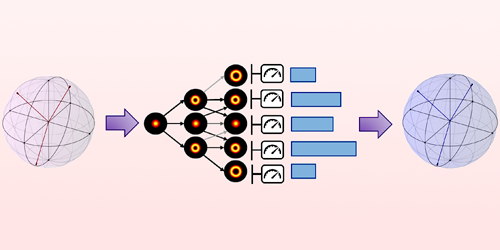Quantum Machine Learning Goes Photonic
In quantum information processing, it is vital to be able to extract features from an experimental dataset while lacking direct knowledge of the system that generated it. One promising approach involves quantum extreme learning machines, which rely on a training dataset to figure out how to estimate a system’s quantum properties based on measurements from uncalibrated devices. Alessia Suprano of the Sapienza University of Rome and her colleagues now apply this framework to reconstruct the initial polarization state of a photon based on measurements of its final orbital angular momentum after it has passed through a series of optical devices [1]. Their experiment uses a relatively small dataset to achieve robust performance, and the reconstruction avoids the need for detailed information about the experimental platform.
In their experiment, the researchers sent single photons through a device that put them in a random initial polarization state. Then, each photon passed through a series of devices that modified this initial state by randomly manipulating the photon’s orbital angular momentum. Finally, an instrument measured the orbital angular momentum of the output photon, and the result was fed to a computer for processing. By sampling 300 such photons, the machine-learning model was trained to reconstruct their initial polarization states.
The researchers say that their machine-learning model offers an agile and resource-efficient approach, performing between 5 and 10 times better than alternative methods for retrieving quantum properties from experimental measurements. They also say that the result highlights the potential of photonic platforms for important quantum information-processing tasks.
–Rachel Berkowitz
Rachel Berkowitz is a Corresponding Editor for Physics Magazine based in Vancouver, Canada.
References
- A. Suprano et al., “Experimental property reconstruction in a photonic quantum extreme learning machine,” Phys. Rev. Lett. 132, 160802 (2024).




